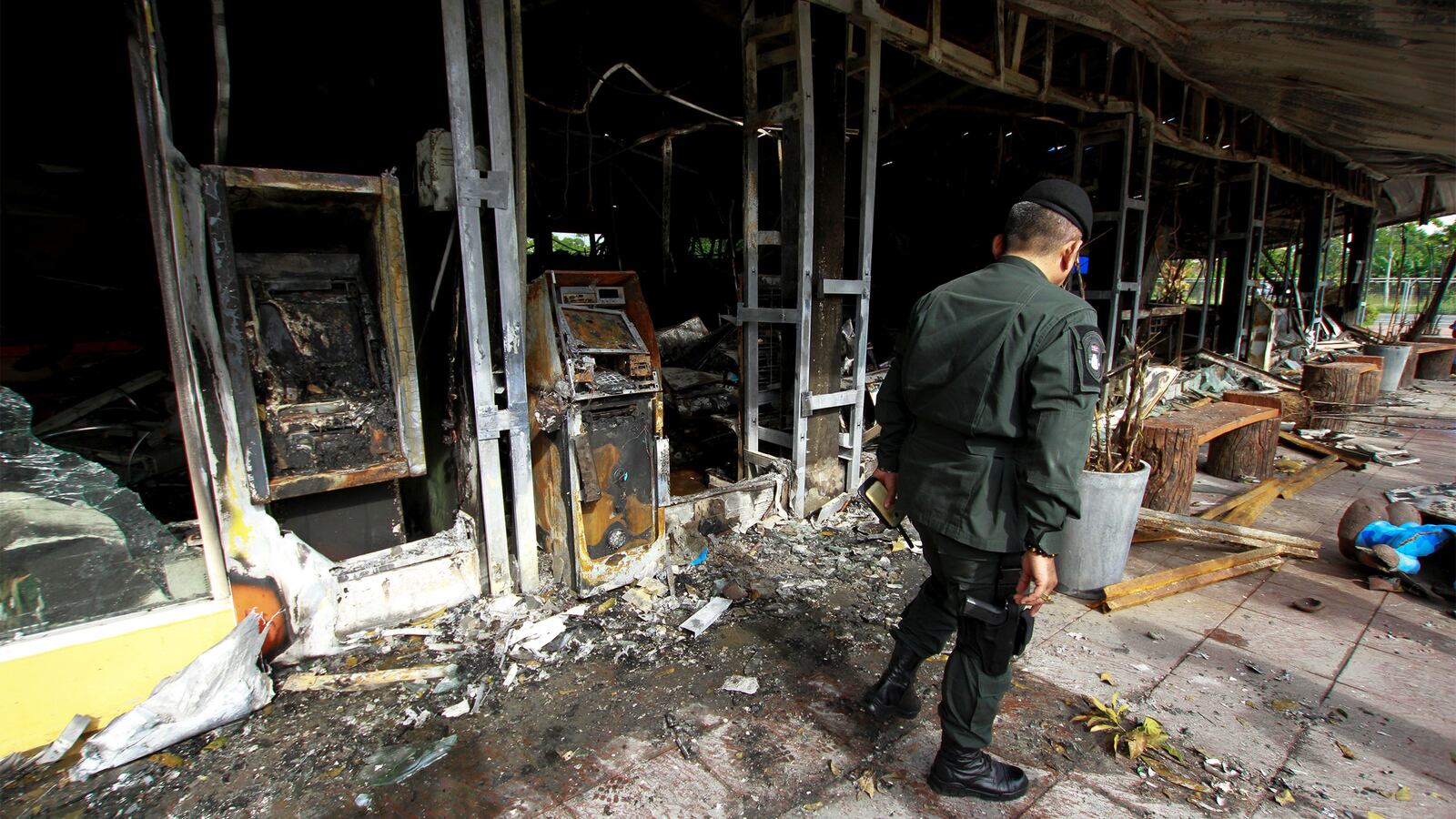Hat Yai is what Sungai Kolok wants to be: an actual den of sin and iniquity. It oozes sex, which runs along its gutters like gunk, clogging them in the rain. The latter hasn’t stopped yet, and won’t before I leave, an hour or two from now. For the first time since leaving Kuala Lumpur, I find myself surrounded by westerners again, most of them older, very few of them reputable. There is the sense of a homecoming—and also that of an ending.
Hat Yai has not been immune to the Islamist-nationalist struggle that has rocked southern Thailand, gently but efficiently, like a mother with swaddling child, since 2004. In 2006, six bombs went off here, killing at least four, including a Canadian citizen, and wounding dozens more. In 2014, it happened again, three IEDs going off within minutes of one another, wounding around eight.
But generally speaking, Hat Yai feels different. Although it has none of the physical beauty of Pattani, it nevertheless feels safer. It feels like Thailand again. And though Thailand has been a military dictatorship since 2014, and while military dictatorships shouldn’t really be considered tourist hot-spots—I mean, we should probably start checking ourselves a bit more on that front—Hat Yai does feel, not like somewhere you want to be, but rather like somewhere you’re happier to be. Beer runs along the gutters with the sex.
I am sitting at the curiously-named Post Laser Disc Pub and Restaurant, waiting to take the overnight train to Bangkok, when Hom comes up to speak to me. We apparently met last night, but I have exactly no recollection of this. Yes, dear reader, I am indeed back in Thailand.
Hom wants to tell me the things she told me last night, when I was drunk and without a notebook. She wants to tell me why she moved to Hat Yai from Yala back in 2012.
It was March of that year when Hom’s parents were killed in a coordinated series of blasts, which occurred within minutes of one another, within a mere hundred-meter radius. The bombs were all hidden in motorcycles and had been planted in the town’s shopping district. Hom's parents owned a store there, she says.
She moved to Hat Yai within the month, not because it was safe, but because it was safe enough while still close to home. Hom has family in Yala, she says, others not willing or able to move. She can’t simply leave them and strike out for the north.
She works at a nail parlor across the street from the bar: she was over here looking for customers when she met me. I was in quite a state, she says, drinking, apparently, to celebrate my good fortune, the fact that I got out of the deep south alive. (This sounds about right.)
I ask about her customers. Most are Malaysians unwilling to risk Sungai Kolok, she says, though there are plenty of westerners about as well. They consider this the end of the line. She has only ever met a few who were continuing south, or who had come that way. Most make a bee-line from the city to the border, or vice versa, not stopping to see the sights. “Southern Thailand has a reputation,” she tells me. I tell her I know exactly what she’s talking about.
It’s amazing how much sleep one can get on an overnight train, especially when one isn’t built for such things. My legs are hanging over the edges of the bed, into the aisles, and my head is at an angle detrimental to brain function. But I arrive at the Hua Lamphong railway station surprisingly well-rested in spite of this, get in a cab, and tell the driver where I want to go. It’s always better to know, in Southeast Asia, exactly where you do want to go, because these guys will fleece you whenever they get the chance. That never happened in the deep south, of course, and it doesn’t happen here, either: I know my way to Khao San Road and am quick to stamp out any unnecessary detours.
I have planned to meet Don Pathan at the Bangkok Foreign Correspondents’ Club, which is these days headquartered in the penthouse of the Maneeya Center on Ploenchit Road. After attending the launch of Benjamin Zawacki’s Thailand: Shifting Ground Between the US and a Rising China, we head out onto the balcony with our beers.
Pathan is a smiling Buddha of a fellow in thin-rimmed glasses and crisp collared shirt. He recognized me the moment I walked in, he says, looking like someone who had just stumbled up from the south. “It was like you had never seen so many white men in one place before,” he says.
Pathan is a security and development consultant and a founding member of the Pattani Forum, a civil society organization dedicated to analysis of the insurgency. He writes regularly for various outlets: living in Yala, his proximity to the conflict, and to its belligerents, renders his work among the best being done down there. He’s also hungry, and we wind up at a nearby McDonald’s. Once again, the Sturm und Drang of the past week feels Pathan says that while the conflict remains essentially ethno-nationalist in nature, he does think the current generation of militants is motivated by religion to a greater extent than its predecessors.
“This generation of militants is much more pious,” he says. “For example, all their dead are buried as shahids, or martyrs. The religiosity stems from the fact that they are from the Barisan Revolusi Nasional, an armed movement that was started by religious figures at the grassroots level.”
“At the same time, Salafi extremists like Jemaah Islamiyah have tried to exploit the situation in the Pattani region but always return to Indonesia or Malaysia empty-handed. These Islamists can't relate to the nationalist sentiment of the Pattani Malays and their powerful narrative.”
He says the movement towards greater religiosity among the insurgents goes some way towards explaining the Thai authorities’ tendency to frame the conflict in such terms.
“The Thai authorities pay lip service to the argument that this conflict is ethno-nationalist in nature, but they’re still looking for Muslim religious leaders to side with them and to issue fatwas saying that the militants have no religious legitimacy to take up arms against the state,” he says.
“But when it comes to religion, you can argue all day and never reach a conclusion. One can find verses in the Quran that one might use to condemn the BRN’s violence, but also verses that support it. If the Thais want to influence the BRN’s behavior, they will ultimately have to talk about international norms, international humanitarian law, and so on.”
Pathan left journalism seven years ago, but continues to write, in his role as a security analyst, “to keep things in perspective to avoid either side from hijacking the narrative,” he says. One rather wonders at the fact that this hasn’t rendered him a target.
“Like every conflict, one has to be careful,” he admits. “I tell myself that they can kill me any time and that the only thing that can save my life is my integrity. Don’t sell your soul to either side, stand your ground, and, though neither side may like what you say, they will at least respect you.”
The one person I don’t meet in Bangkok is Lawrence Osborne, the author whose book, The Wet and the Dry, inspired me to visit Thailand's deep south in the first place. We come close at one point, but there’s a problem with my Uber motorcycle, and, by the time I arrive at the agreed-upon destination, Osborne has moved on to a rendezvous with his girlfriend. Like ships in the night, or hunters in the dark, we can’t quite make it work. It would have been nice to have compared notes.
The deep south that Osborne writes about in The Wet and the Dry bears only superficial resemblances to the region I have experienced first-hand over the past week. This is hardly surprising. Osborne visited the region when the violence was still at its height—and, it must be said, when it was still in the headlines. I was there nearly a decade later, once that violence had become de rigueur, once it had become, as Pathan put it in a recent article, normalized. When former Southeast Asia correspondent Lindsay Murdoch used to write about the place for The Sydney Morning Herald, he never failed to mention that the conflict is “little-publicised”. Obviously, he had self-serving reasons for doing so, as indeed all journalists covering out-of-the-way places do. But he wasn't wrong. Most of what I read about the conflict over the course of the past week or so has been in small online publications, mostly English-language Thai outlets, or else in reports issued by think-tanks and academic institutions. That the body count continues to climb in Thailand’s deep south seems neither here nor there: when it comes to insurgencies, even Islamic ones, the focus tends to remain, as ever, on the Middle East.
There are countless reasons as to why this is the case. The West has “interests” in the Middle East. We’ve been there, in one form or another, for the better part of two centuries, not least since the Bush administration upped the ante nearly two decades ago. The West doesn’t have that relationship with Thailand, the one country in Southeast Asia that we never managed to submit to the colonial yoke, and the situation remains difficult to explain to readers. It has taken us this long to learn the difference between Sunni and Shia. Can we really be expected to learn about the Sultanate of Pattani’s long relationship with the Kingdom of Siam as well?
But ignorance is only bliss for the ignorant. For those living in Thailand’s deep south, it’s ultimately a condemnation: to more of the same, to another fourteen years, to the prospect of becoming another of the world’s unanswerable questions.
On Khao San Road, tourists drink liquor from buckets and challenge one another to eat scorpions on skewers. It’s a whole other world: the Thailand of lore, of Garland’s The Beach, of backpackers’ adolescent fever dreams. A thousand kilometers away, however, the heavens are open, and the rain still falls.
This is the fourth and final part of our series exploring Thailand's separatist south. Click the links for parts one, two, and three.




